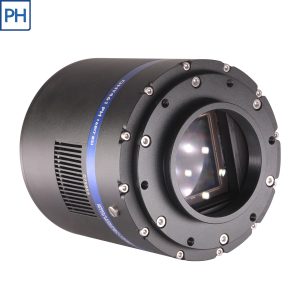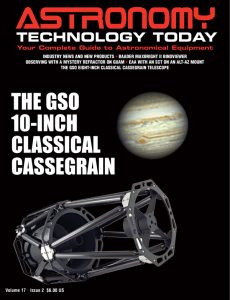The new QHY461 PH Camera is a monochrome BSI CMOS camera with 102 megapixels, 16bit AD conversion, offering the highest quantum efficiency with extremely low readout noise. It is a complete redesign of the larger, scientific camera – the QHY 461M Pro monochrome model -providing a new, more compact housing. The main benefit of the QHY461M PH camera is that it offers all the features and performance essential for astrophotography at a significantly lower price point than the QHY461M Pro.
 The QHY461 PH Camera utilizes the Sony IMX461, which is a BSI Exmor R sensor with a similar architecture to its bigger brother, the IMX411. The sensor has a size of 44mm x 33mm with a 55mm image diagonal. The array has 11,656 x 8,742 pixels (102 megapixels) with square 3.76 µm pixels.
The QHY461 PH Camera utilizes the Sony IMX461, which is a BSI Exmor R sensor with a similar architecture to its bigger brother, the IMX411. The sensor has a size of 44mm x 33mm with a 55mm image diagonal. The array has 11,656 x 8,742 pixels (102 megapixels) with square 3.76 µm pixels.
The BSI technology of the IMX461 sensor leads to an extraordinarily high quantum efficiency (max. 90% at 540nm) and, thanks Exmor BSI CMOS technology, has an extremely low dark current. This means that, due to its high sensitivity and low readout noise, the camera is not only suitable for short exposure times, but also for long exposure times, where dark current noise often dominates.
The IMX is the world’s first scientific CMOS sensor with a 16-bit AD converter “on board”. The data output delivers true 16-bit with 65,536 gray levels. Compared to cameras with 12/14 bit sensors, the QHY461 PH offers a higher sampling resolution and the system gain is less than 1e-/ADU with very low readout noise.
The QHY461 PH Camera has only one electron readout noise (1 e-) with high amplification and a high – for the large dimensions of the sensor – readout speed of 1.3 frames per second (fps) at 16 bit, or 2.7 frames per second with 8-bit AD conversion.
Another advantage of the BSI CMOS structure is the increased full-well capacity. This is particularly important for sensors with small pixel dimensions. Even with unbinned 3.76 µm pixels, the QHY461 PH has a full well capacity of 50 ke-. With a binning of 2×2 to 7.5 µm, the full-well capacity is already 204 ke- and with a binning of 3×3 to 11 µm it is 408 ke-. The QHY461 PH also offers 4 different readout modes, including an extended full-well mode. In expanded mode, full-well capacity is 80 ke-unbinned, 320 ke-binned 2×2, and 720 ke-binned 3×3.
Many DSLR cameras have a RAW image output, but this is usually not completely without internal processing. Upon closer inspection, some traces of noise reduction and hot pixel removal are visible. This can have a negative effect on the image in astronomy. However, the QHY461M PH (and also the other QHY models with a 16-bit AD conversion) offers a true raw image output and generates an image consisting only of the original signals of the individual pixels, giving maximum flexibility for astronomical image processing programs.
The technology of the QHY461 PH Camera is based on almost 20 years of experience in the development of cooled CMOS cameras and offers solutions for icing and dew control. The optical entrance window has a built-in heater to protect dew on the entrance window and the sensor chamber from internal moisture condensation. The sensor itself is kept dry using a desiccant tube base design to control the humidity in the sensor chamber.
The IMX461-PH offers frost and dew control solutions as the optical window has a built-in dew heater and the chamber is protected from internal humidity condensation. The camera is cooled using dual stage TE cooling and a proprietary hardware technology to control dark current noise.
The electronics of the camera are designed in such a way that the +12V power supply can be used to restart the camera WITHOUT the USB interface having to be disconnected and reconnected. This means you can restart the camera simply by turning off the +12V and then turning it back on. This function is essential for the remote operation of a telescope! You can simply use a remote controllable power supply to restart the camera.
 The QHY461M PH employs innovative proprietary technology that significantly reduces the level of random thermal noise. This is employed to combat the trend of certain types of thermal noise in BSI CMOS cameras changing over time and, as a result, each image has an individual characteristic of thermal noise, which makes it difficult to reduce it by subtracting a dark image. The QHY461M PH design helps reduce this characteristic.
The QHY461M PH employs innovative proprietary technology that significantly reduces the level of random thermal noise. This is employed to combat the trend of certain types of thermal noise in BSI CMOS cameras changing over time and, as a result, each image has an individual characteristic of thermal noise, which makes it difficult to reduce it by subtracting a dark image. The QHY461M PH design helps reduce this characteristic.
As the QHY team notes, “It is common behavior for a CMOS sensor to contain some horizontal banding. Normally, random horizontal banding can be removed with multiple frame stacking so it does not affect the final image. However, periodic horizontal banding is not removed with stacking so it may appear in the final image. By adjust the USB traffic in Single Frame mode or Live Frame mode, you can adjust the frequency of the CMOS sensor driver and it can optimize the horizontal banding appeared on the image. This optimized is very effective to remove the periodic banding in some conditions.’
They also noted, ‘Our daily life experience tells us that the actual operational voltage of an electrical device must not significantly exceed the rated voltage, otherwise it will be damaged. For such precision equipment as cameras, long-term work at too low input voltage can also be detrimental to the working life of the camera, and may even make some devices, such as power manager, burn up due to long-term overload. The camera offers UVLO(Under Voltage Locking) to protect the device from damage caused by abnormally low voltages. In the all-in-one driver and SDK after 2021.10.23 stable version, the camera will give a warning when the input voltage of the camera is below 11V.”
They also commented, “The camera is designed to use the +12V to reboot the camera without disconnecting and reconnecting the USB interface. This means that you can reboot the camera simply by shutting down the +12V and then powering it back on. This feature is very handy for remote controlling the camera in an observatory. You can use a remotely controlled power supply to reboot the camera. There is no need to consider how to reconnect the USB in the case of remote control.”
The QHY461 PH Camera specifications include:
– Sensor: Sony BSI IMX 461
– Sensor resolution: 102 megapixels with a pixel size of 3.76 µm x 3.76 µm
– Image resolution: 11760 × 8896
– Sensor size: 44 x 33 mm, image diagonal 55 mm
– Sensor surface glass: AR+AR Multi-Coating Clear Glass
– Full well capacity (1×1, 2×2, 3×3): 50ke- /200ke- /450ke- in Standard Mode; 80ke-/ 320ke- /720ke- in Extend Full Well Mode
– AD conversion: 16-bit (0-65535 greyscale) for 1X1Binning; 18bit in 2X2; 19BIT in 3X3; 20BIT in 4*4 software Binning
– Read noise: 1e- to 3.7 e- (depending on readout modes)
– Exposure time range: 50us – 3600sec
– Frame rate: 2.7FPS @ 8BIT 1.3FPS@16BIT on USB3.0; 2.7FPS @ 16BIT 6FPS @ 14BIT on 10Gigabit Fiber
– Quantum efficiency: Max. 90% at 450 nanometers
– Dark current noise: Approx 0.003e/pixel/sec @ -20C
– Built-in image buffer: 1GByte DDR3 Buffer
– Shutter type: Electric Rolling Shutter
– Cooling System: Dual Stage TEC cooler (-35C below ambient with air cooling)
– Data interface: USB 3.0
– Filter wheel interface: 4PIN QHYCCD CFW Port
– Amp glow: None
– Anti-dew: Yes
– Noise reduction: Selectable
– Optic window type: AR+AR high quality multi-layer anti-reflection coating
– Back focal length: 32.5mm
– Image reading: 4 different modes
You can learn more about the QHY461 PH Camera here.

 And to make it easier for you to get the most extensive news, articles and reviews that are only available in the magazine pages of Astronomy Technology Today, we are offering a 1-year magazine subscription for only $6! Or, for an even better deal, we are offering 2 years for only $9. Click here to get these deals which only will be available for a very limited time. You can also check out a free sample issue here.
And to make it easier for you to get the most extensive news, articles and reviews that are only available in the magazine pages of Astronomy Technology Today, we are offering a 1-year magazine subscription for only $6! Or, for an even better deal, we are offering 2 years for only $9. Click here to get these deals which only will be available for a very limited time. You can also check out a free sample issue here.
The sun is more active than it has been in years! If you’d like to learn more the technology behind solar observing, solar imaging and more, you can check out our free publication, “The Definitive Guide to Viewing and Imaging the Sun”. You don’t have to sign up or provide any information, simply click here and enjoy reading!



